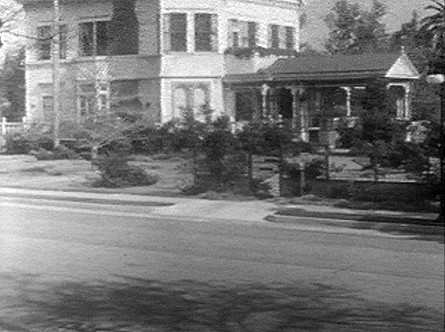For devotees of the iconic 1960s TV series “The Addams Family,” starring John Astin and Carolyn Jones, the enigmatic mansion that served as the exterior of the Addams residence is as much a character as Gomez, Morticia, Wednesday, or Pugsley. If you’ve ever wondered whether the Adams Family House was based on a real structure, you’ve come to the right place to uncover the fascinating truth behind this spooky abode.
 Original Addams Mansion inspiration in Chester Place, Los Angeles
Original Addams Mansion inspiration in Chester Place, Los Angeles
It’s a question that has intrigued fans for decades: Was the Addams Family house a figment of television magic, or did a real-world counterpart inspire its eerie charm? The answer is a captivating blend of both. While the interior scenes were undoubtedly filmed on studio sets, the exterior shots, particularly in the show’s initial episodes, drew inspiration from a very real, and very grand, house located in the historic Chester Place of Los Angeles.
This website is dedicated to exploring the history and allure of this remarkable house. As a passionate admirer of the 1960s “Addams Family” series, I embarked on a journey to uncover the facts surrounding the house that sparked the imagination of the show’s creators. While I am continuously learning and refining the information presented here, my goal is to share the story of this captivating residence and ensure its legacy endures.
My research has been enriched by the invaluable contributions of several sources. I highly recommend Don Sloper’s book, “Los Angeles’s Chester Place: Images of America,” which offers a detailed look into the prestigious gated community where the house once stood. His work provided a crucial foundation for understanding the historical context of the area. Additionally, Ruth Waldo Newhall’s “The Story of the Newhall Land and Farming Company,” and “Hometown” by Handlebar, “Confessions of a love God” by Mark J. Denger, Norman S. Marshall & John R. Justice (for insights into Lieutenant Commander Morgan Adams’ Navy career), Richard Finnie’s “Earth-moving, fifty years on heavy engineering projects; a record of the Grafe-Callahan construction company,” and Cate Austin (granddaughter of Paul and Helen Grafe, the house’s last residents), who generously shared personal memories, have all been instrumental in piecing together the story.
Furthermore, I extend my gratitude to Duncan Maginnis of The Underappreciated Legacy of Historic Los Angeles, Ronny Kellum, Kansas Sebastian, oldhomesoflosangeles, Matt Hardesty, gilroytg, Guido Ligorio, Stuart Armstrong, and Nick Cook for their support and assistance. Finally, a posthumous acknowledgement to Henry G. Newhall, the visionary behind this magnificent structure, David Levy, the creator of the “Addams Family” sitcom, Louis McManus, who designed the “Addams Family” house for the screen, and the inimitable Charles Addams, the originator of the Addams Family characters themselves.
Like many, my fascination with “The Addams Family” began in childhood during syndication in the 1980s. The show’s unique blend of macabre humor and heartwarming family dynamics was instantly captivating. However, it was the Addams mansion itself that truly seized my imagination. As a child, I, like many, initially believed the house to be real, a tangible place where this eccentric family resided. The grandeur and spookiness of the Second Empire style mansion were so compelling, it was easy to imagine it existing somewhere in the real world.
As I watched more episodes, the realization dawned that the iconic house was, in fact, a clever combination of matte paintings and studio sets. While a touch disappointing to discover it wasn’t a fully real house, this revelation only deepened my interest. The artistry and imagination behind creating such a believable and distinctive home sparked a new kind of appreciation. I began sketching the house, envisioning floor plans, and dreaming of a house that captured the same unique aesthetic.
Then, a discovery: the very first episode of “The Addams Family.” In it, glimpses of a real house appeared, not the Second Empire mansion of later episodes, but a house nonetheless. Years later, the advent of the internet opened up a treasure trove of information. While initial online searches yielded limited results, a chance encounter with a message board discussing the real house reignited my childhood fascination and set me on the path of dedicated research.
Through this research, I discovered a thriving community of “Addams Family” enthusiasts, individuals who shared my fascination with the show and its iconic imagery. The enduring popularity of “The Addams Family,” often contrasted with “The Munsters,” demonstrates the lasting impact of these classic shows and their continued appeal, particularly around Halloween.
My affection for the Addams Family house, and the real-life house that inspired it, has only grown over time. The fragmented pieces of information shared by early enthusiasts became a compelling puzzle, driving me to uncover the complete story. While online information about the house and its connection to “The Addams Family” can be scattered and sometimes inaccurate, and while Don Sloper’s book focuses more broadly on Chester Place, my aim is to provide a focused and accurate account of the house itself, its inhabitants, and its fascinating link to television history.
Therefore, I present this compilation of my research, dedicated to revealing the real house that served as the initial inspiration for the Addams Family home, featured in the pilot episode, and established the visual foundation for the iconic mansion of the 1964-66 “Addams Family” TV series.
Continue to ‘House History‘

